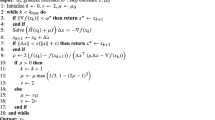Abstract
The goal of the Dynamic Buchberger Algorithm is to compute a Gröbner basis quickly by adjusting the term ordering as the computation proceeds. A known problem concerns the size and number of linear progams to be solved when refining the ordering. This paper describes two methods for reducing both their size and number.










Similar content being viewed by others
Notes
This notion is essentially Caboara’s notion of a potential leading term with respect to \(F\), \(\mathrm{lt}\left( F\right) \). Our choice of different vocabulary allows us to emphasize that a “potential” leading term for one polynomial is not usually “compatible” with previous choices.
References
Bigatti, A.M., Caboara, M., Robbiano, L.: Computing inhomogeneous Gröbner bases. J. Symb. Comput. 46(5), 498–510 (2010). doi:10.1016/j.jsc.2010.10.002
Bosse, H., Gärtner, C., Golubitsky, O.: Ideal specific elimination orders from a star-shaped region. J. Symb. Comput. 56, 69–79 (2013)
Buchberger, B.: Ein Algorithmus zum Auffinden der Basiselemente des Restklassenringes nach einem nulldimensionalem Polynomideal (An Algorithm for Finding the Basis Elements in the Residue Class Ring Modulo a Zero Dimensional Polynomial Ideal). Ph.D. thesis, Mathematical Institute, University of Innsbruck, Austria (1965). English translation published in the Journal of Symbolic Computation (2006) 475–511
Caboara, M.: A dynamic algorithm for Gröbner basis computation. In: ISSAC’93, pp. 275–283. ACM Press, New york (1993)
Eder, C., Perry, J.: Signature-based algorithms to compute Gröbner bases. In: Proceedings of the 2011 International Symposium on Symbolic and Algebraic Computation (ISSAC’11), pp. 99–106. ACM Press (2011). doi:10.1145/1993886.1993906. Preprint available online at arxiv.org/abs/1101.3589
Faugére, J.C.: A new efficient algorithm for computing Gröbner bases (F4). J Pure Applied Algebra 139(1–3), 61–88 (1999)
Faugère, J.C.: A new efficient algorithm for computing Gröbner bases without reduction to zero F5. In: International Symposium on Symbolic and Algebraic Computation Symposium—ISSAC 2002, Villeneuve d’Ascq, France, pp. 75–82 (2002). Revised version downloaded from http://fgbrs.lip6.fr/jcf/Publications/index.html
Giovini, A., Mora, T., Niesi, G., Robbiano, L., Traverso, C.: “One sugar cube, please” OR Selection strategies in the Buchberger algorithm. In: Proceedings of the 1991 International Symposium on Symbolic and Algebraic Computation, pp. 49–54. ACM Press, New York (1991)
Golubitsky, O.: Converging term order sequences and the dynamic Buchberger algorithm (in preparation). Preprint received in private communication
Gritzmann, P., Sturmfels, B.: Minkowski addition of polytopes: computational complexity and applications to Gröbner bases. SIAM J. Disc. Math. 6(2), 246–269 (1993)
Klee, V., Minty, G.: How good is the simplex algorithm? In: Inequalities III (Proceedings of the Third Symposium on Inequalities), pp. 159–175. Academic Press, New York (1972)
Mora, T., Robbiano, L.: The Gröbner fan of an ideal. J. Symb. Comput. 6, 183–208 (1988)
Stein, W.: Sage: Open Source Mathematical Software (Version 4.8). The Sage, Group (2012). www.sagemath.org
Tran, Q.N.: A new class of term orders for elimination. J. Symb. Comput. 42(5), 533–548 (2007)
Acknowledgments
The authors would like to thank Nathann Cohen for some stimulating conversations, and his assistance with Sage’s linear programming facilities. Suggestions by the anonymous referees greatly improved the exposition, particularly the abstract.
Author information
Authors and Affiliations
Corresponding author
Rights and permissions
About this article
Cite this article
Caboara, M., Perry, J. Reducing the size and number of linear programs in a dynamic Gröbner basis algorithm. AAECC 25, 99–117 (2014). https://doi.org/10.1007/s00200-014-0216-5
Received:
Revised:
Accepted:
Published:
Issue Date:
DOI: https://doi.org/10.1007/s00200-014-0216-5




